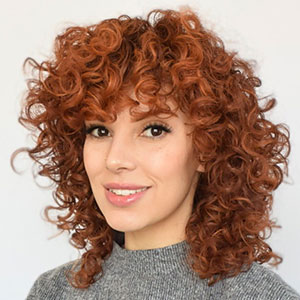
Get the latest Academy content and special deals direct to your inbox
In this long layers razor cut tutorial, you’ll learn how to cut layers with a Feather Plier Razor, an unguarded razor. Razored haircuts for long hair are popular styles that give volume, dimension and a lived-in look. Razored long hairstyles can be created with a guarded razor as well, but here we take a look at using the premium Plier!
A razor haircut for long hair is perfect for women who like movement in their hair, feel their hair is too heavy and need weight removal. Razored layers tend to grow out nicely and you can go for long periods of time before needing to get another haircut. Follow along with this tutorial and the transcript below.
Welcome to Jatai Academy. You have fear of using a razor. You have a fear of using it on long hair. Are you afraid you’re going to just take out too much and it’s just going to be a stringy mess? I’m going to solve all those problems today.
We’re going to show you how to control how much weight you’re taking out. We’re going to show you how deep that you want to go through and add your texture and also how to add detail and make it the perfect amount of texture internally without layering. So let’s get started.
Starting off razoring long hair, there’s a couple of key points that you really need to pay attention to to make it to where you’re not fighting yourself and causing more harm and damage than good.
We want a soft wispy separated shape and there’s a key technique that we’re going to show you on how to get that, but first thing let’s cover how to hold the razor.

Alright, so I’m going to take my razor where the black handle is. I’m going to put between my forefinger and my middle finger like this. Now I’m going to push the blade away from my palm, clasp my thumb around, rotate my fingers around like this and then I can use just my finger to create motion.
I can also use my wrist. And if I’m taking broad strokes I’ll use my elbow. When I go and take a section, it can’t be too thick. If the section’s too thick, the razor can’t handle that much hair and it’s going to end up pushing it out of the blade and you’re going to end up with a really inconsistent cut.
I think that’s one of the biggest mistakes people make is they take too much hair and a blade that’s not sharp enough.

So I’m going to keep my razoring to the bottom third. Now if I want I can go through and start razoring my length off or I can start channeling it or I can do both at the same time.
I can channel and cut length at the same time. Comb everything straight down, put the blade in about a third of the way down through and then cut my length off.
Keeping in mind that I want to create a lot of softness and a lot of separation in the texture. I’m not worried about the line being perfectly blunt cut. I’m not worried about that precision. I want texture.
So pay attention to the texture more so than the overall length sure. I want to make sure it’s even on both sides, but I’m not going to be real fine-tuned and OCD about making sure the line’s perfect. Move on to the other side.
Cut my channel through. There’s my length. Cut the length off at the same time. There we go. Now I’m going to go through on the other side, cut my channel, cut my channel, cut my channel and then cut my length.
Now when I first start using the razor especially a guardless razor, if I’m using one with a guard it’s no problem. But a guardless razor as I go through and take sections, I will close the blade so I don’t risk cutting myself as I go through and start pulling down other sections of hair. Then, when I’m ready, reopen the blade back in and we’re ready to go.
Next section. I’m holding everything straight down, following through, getting my channel and then if there’s anything on the length, cut that length off. This can move pretty rapidly once you get a good rhythm going and you get a good methodology and you get a good approach.
There’s a little bit right there. We’re going to take just that off a little bit and we’re looking good. This is what I’m looking for is this separation on the bottom.

So I’m only going to go through and razor the hair above it so I don’t end up cutting more off than I want to. So I’ll separate that completely and visually guess where that overall length is. It’s pretty easy to see we’re about right there.
Now we’ll go through put our channels into it very very deep and pretty strong and then guesstimate at where that overall length is going to be.
It does not have to be perfect, but I do want to make sure that I keep my next section out of the underneath section when I comb that down. There’s my overall length.
Let’s go through channel some of that hair out. Now this works really well on hair that’s overly thick and doesn’t have a whole lot of movement to it. If she had very very fine hair I would not go through and channel as deep as I am on this particular head of hair. There’s my length. Cut that down and through.
And then cut my length off. That’s looking pretty good. Now what I find is if I go through and don’t separate the hair underneath, what ends up happening is the hair on top feels overly thick compared to the hair underneath.
I feel like I start missing the weight of this perimeter weight line underneath. So this is just a safety net to prevent me from over thinning that.
An easy way to make sure I don’t pick up the hair underneath I can just take a clip and then another clip and then when this hair lays on top of it I don’t have to worry about it. It’s not so easy to pick up.
My next section. And I’m going to continue on with this methodology until I’ve cut the entire perimeter shape.
Follow us on your favorite social media @jataifeather
I’m coming into my last section here. And another variation of this technique that I’m going to show you is if the hair already has enough separation on the bottom and I just want to remove thickness, then what I’ll do is I will thin it just like I was doing before.
But instead of running all the way through to the tip, I’m only going to do a little bit about halfway. So that way I can remove the weight without removing so much weight on the ends as if I was to go all the way down the section.
If I already feel that I have enough separation, then that’s fine. Just doing a little bit right in the middle of the section is enough to remove the weight and balance out the weight throughout the rest of the haircut without making the ends way too wispy.

So what I’ll do there is I’ll take my center section. I will go through and do the same sort of thing. But on the right side since I want the movement to go to the right and I want to layer underneath a little bit less, I’m going to focus more on the surface of the section as opposed to going just straight in and channeling it.
So instead of just going straight in and channeling I’m focusing more on the surface layer with steps in between. That way I can start to remove the weight without any little stubs sticking straight up in the air.
And then to make sure I get the length going I’ll start shorter in the center and build up some texture and length going to the right and then going to the left. If I feel like I need to take a little more weight out, I’m going to do the same thing.
I’m going to fillet this off so I hit the surface of the section not the underneath of the section. That is most important just around the bang area. The rest of it you can go through and do whatever you’ like. Either way works just fine.
My next section here and this should be pretty much it just a formality to make sure nothing really hangs over the sides. Again roll down. There’s a little weight right through there so we’re going to filet that off.
After I finish on both sides I’m going to go through and blow her dry so we can see the results.
Here’s our end result of this razor cut for long hair and I think we’re looking pretty good. And the whole point of this video of using a razor on long hair was to demonstrate that it’s not just for short hair.
I mean some people are scared of the razor you know. They’re afraid to cut any kind of long hair with it and you can use it on long hair to great effect in the right way.
So we don’t go more than half the depth of the hair. We pay attention to how much of the ends that we’re taking out to get our pieciness. And we don’t cut the underneath hair as our guide in each section as we go up.
And that all gives you a much better result like this. And I think she looks pretty good. I think we got a nice texture to it and this is without any kind of layering at all. You get all of this separation and this faux layering just by doing that deep channeling and by going through and putting that invisible kind of layer through it. I hope you learned something about how to razor cut long hair.
So anyway check out the Jatai Academy. There’s all kinds of fantastic information on there that will make you better hairstylist and barber. Also let us know what you’d like to see in the future. Thank you so much for watching. We’ll see you next time.
Haircuts with razored layers are versatile and work best on thick hair. When you razor cut long hair, it’s important to use techniques that are applicable to the client’s hair density and thickness. This long razor cut hair is perfect for many women that’s timeless and classic.

JATAI provides innovative and professional quality beauty implements with world-class customer service and educational support. To offer great products as a master distributor, we seek out and select only manufacturers who demonstrate superior workmanship, the most advanced technology, and respected business core values of reliability, honesty and integrity. Accordingly, JATAI represents three major ‘workhorse’ brands that dominate within their categories. Feather, Seki Edge and Fuji Paper. JATAI Academy brings beauty tools to creative life. It’s the ultimate professional information resource where Education, Artistry and Trends CONNECT for Stylists and Barbers.









